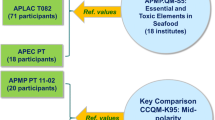Abstract
Following implementation of the CLIA ‘88 laboratory regulations, the primary role of proficiency testing (external quality assessment, PT) in the U.S. has been widely viewed as one of assuring regulatory compliance. PT can also be an effective tool for detecting widespread analytical problems, subject to limitations based on the method of PT assigned value determination. A recent case study describes the role of two PT programs in detecting and resolving a calibration bias in the LeadCare blood lead analyzer, and illustrates the limitations of peer-group target determination in fulfilling that PT role.

Similar content being viewed by others
References
Shannon M, Rifai N (1997) Ambul Child Health 3:249–254
Taylor L, Jones RL, Kwan L, Deddens JA, Ashley K, Sanderson WT (2001) Am J Ind Med 40:354–362
Parsons PJ (1992) Environ Res 57:149–162
Parsons PJ, Reilly AA, Esernio-Jenssen D, Werk LN, Mofenson HC, Stanton NV et al (2001) Clin Chem 47:322–330
Stanton NV (1993) J Int Fed Clin Chem 5:158–161
Wadsworth Center, New York State Department of Health,2005–2, 2005–3 Blood Lead Proficiency Test Event #2 and #3 (2005) http://www.wadsworth.org/testing/lead/ptresults.htm (Accessed December 2005)
Wisconsin State Laboratory of Hygiene. National Blood Lead Proficiency Testing Program, June 2005 Data Summary [report] (2005) Madison, WI: University of Wisconsin
Tietz NW, Rodgerson DO, Laessig RH (1992) Clin Chem 38:473–475
Büttner J (1995) Eur J Clin Chem Clin Biochem 33:981–988
Rej R, Norton-Wenzel CS, Cao Z (2001) Clin Chem 47:2185–2186
Palmer-Toy DE, Wang E, Winter WE, Soldin SJ, Klee GG, Howanitz JH et al (2005) Arch Pathol Lab Med 129:305–309
Acknowledgements
Contributions of the WI PT program were supported by grant H46MC00123 from the Bureau of Maternal and Child Health, Health Resources and Services Administration, US Dept. of Health and Human Services. The authors also wish to acknowledge Dr. Eric Zink and Robb Morse of ESA for their efforts during the investigation, and for their helpful review of this manuscript.
Author information
Authors and Affiliations
Corresponding author
Rights and permissions
About this article
Cite this article
Stanton, N.V., Fritsch, T., Geraghty, C. et al. The role of proficiency testing in the detection and resolution of calibration bias in the LeadCare® blood lead analyzer; limitations of peer-group assessment. Accred Qual Assur 11, 590–592 (2006). https://doi.org/10.1007/s00769-006-0189-6
Received:
Accepted:
Published:
Issue Date:
DOI: https://doi.org/10.1007/s00769-006-0189-6




